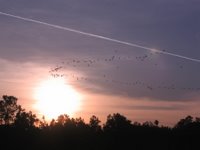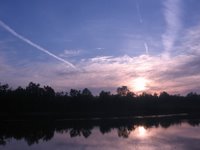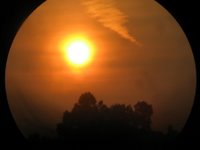Ducks Unlimited
Previously on Riverlogue, the postings told the story of hunting ducks along Warren Ditch, below Gueydan. Various legal and not-so-legal activities were described. And seeing wood ducks flying over the river this morning brings up more duck stories.

This story is one I partly witnessed, and heard parts of, around 1949 in the same area. As mentioned, it was common in this area, below Gueydan, to hear of market hunting (and selling), and to see it from time to time. The whole country below Gueydan, Kaplan, etc., was loaded with ducks and geese every year. Cajuns had traditions that included harvesting large amounts of game by whatever means was practical. When the federal government began to set limits on how much one person could harvest, these traditions became illegal to the extent that they exceeded the limits, and of course selling the birds had pretty much been illegal for a long time. But, traditions being what they are, and Cajuns being who they are, the practices didn’t die out immediately; they just were done in more-or-less more circumspect ways. A common way to harvest large numbers of waterfowl on large bodies of water was to mount a large-gauge shotgun (almost a cannon) on the front of a boat and drift onto the huge bodies of ducks and geese sitting on the water. I hear that the harvest from one such shot was enough to make you wonder that the market for the game was that big, but it seems it was.
If you didn’t have a big body of water that attracted ducks, you had to improvise, and Cajuns are good at that. A lot of dryer prairie country attracted ducks and geese too. A related situation is that the area around, and coastal fro
 m, Gueydan has long had a cattle orientation. The cattle that seem to do very well close to the marshes, and the associated mosquitoes, are brahmas, or at least a mixed breed incorporating brahma blood. To get this blood distributed within his herd, most cattlemen down there used brahma bulls. Now, this isn’t a cow story, so back to the ducks. So, you could see these big bodies of ducks and geese out in the rice fields and marshes, and a man could creep up on them sometimes, and sometimes by crawling on his belly in the cold water and mud behind a rice levee, get close enough for a shot or two. If you were lucky you would get some birds, even a few dozen if you were really willing to suffer and the birds didn’t see you and all take off before you could get close enough to shoot. But my Cajun cousins could look out at the thousands of birds in the big flocks and wonder about a better way. They noticed that the ducks and geese would land in the fields/marshes that contained cattle. The cattle would just walk around in the field of feeding/resting ducks and geese and the waterfowl would pay no attention. I don’t know how long it took for these prairie Cajuns to realize that this knowledge could be used to advantage. Observers of nature that they are, I’ll bet it didn’t take very long to figure it out. Soon some of them began to hide behind bunches of cattle and try to sneak around the cows and get close to the birds that way. That was better and kept you out of the cold water, but still not that good. Besides, discharging shotguns in the middle of a bunch of skittish cattle could be dangerous. Someone finally decided to use one cow and stay behind it while it walked toward the birds. Problem was, the cows didn’t always walk where you w
m, Gueydan has long had a cattle orientation. The cattle that seem to do very well close to the marshes, and the associated mosquitoes, are brahmas, or at least a mixed breed incorporating brahma blood. To get this blood distributed within his herd, most cattlemen down there used brahma bulls. Now, this isn’t a cow story, so back to the ducks. So, you could see these big bodies of ducks and geese out in the rice fields and marshes, and a man could creep up on them sometimes, and sometimes by crawling on his belly in the cold water and mud behind a rice levee, get close enough for a shot or two. If you were lucky you would get some birds, even a few dozen if you were really willing to suffer and the birds didn’t see you and all take off before you could get close enough to shoot. But my Cajun cousins could look out at the thousands of birds in the big flocks and wonder about a better way. They noticed that the ducks and geese would land in the fields/marshes that contained cattle. The cattle would just walk around in the field of feeding/resting ducks and geese and the waterfowl would pay no attention. I don’t know how long it took for these prairie Cajuns to realize that this knowledge could be used to advantage. Observers of nature that they are, I’ll bet it didn’t take very long to figure it out. Soon some of them began to hide behind bunches of cattle and try to sneak around the cows and get close to the birds that way. That was better and kept you out of the cold water, but still not that good. Besides, discharging shotguns in the middle of a bunch of skittish cattle could be dangerous. Someone finally decided to use one cow and stay behind it while it walked toward the birds. Problem was, the cows didn’t always walk where you w anted them too, probably resulting in many an abused cow by a frustrated hunter. But the solution was found when an enterprising person selected a more-than-usually docile brahma bull (interesting to think about the process of weeding out those that weren’t docile) and actually trained it to obey commands from a human walking along beside it and giving directions by tapping it with a stick on one side of its neck or the other. Once this bull was trained, you could place two men to walk beside it, one behind the front legs and one beside the back legs. You would direct the bull to within easy range of the birds being hunted, and by some signal unknown to me, make this huge animal stop. The men would drop down behind a rice levee and point the guns over the levee. The bull was trained to walk on a few paces and then stop again, and wait. One whistle from one of the men would make all of the birds lift their heads to see what the strange noise was and the men would discharge the shells they had in the direction of the birds. The shotguns would each have the full compliment of shells that they were made to hold (five), not the three shells apiece that is legal now. The 10-gauge or 12-gauge shells would make a serious impression in the flock of waterfowl, especially with a total of ten shots. The un-hit birds would rise in a tremendous roar that would be truly deafening, but it probably wasn’t even noticed by the men for the adrenalin pumping like water under pressure. The men would pull out string that they had brought and began to collect and tie up the ducks or geese. The bull, which somehow was trained not to run away from the gunshots, was brought back and the birds were slung over its back for easy transport back to the waiting vehicles somewhere. It was not unusual for the bull to have to carry 100 ducks.
anted them too, probably resulting in many an abused cow by a frustrated hunter. But the solution was found when an enterprising person selected a more-than-usually docile brahma bull (interesting to think about the process of weeding out those that weren’t docile) and actually trained it to obey commands from a human walking along beside it and giving directions by tapping it with a stick on one side of its neck or the other. Once this bull was trained, you could place two men to walk beside it, one behind the front legs and one beside the back legs. You would direct the bull to within easy range of the birds being hunted, and by some signal unknown to me, make this huge animal stop. The men would drop down behind a rice levee and point the guns over the levee. The bull was trained to walk on a few paces and then stop again, and wait. One whistle from one of the men would make all of the birds lift their heads to see what the strange noise was and the men would discharge the shells they had in the direction of the birds. The shotguns would each have the full compliment of shells that they were made to hold (five), not the three shells apiece that is legal now. The 10-gauge or 12-gauge shells would make a serious impression in the flock of waterfowl, especially with a total of ten shots. The un-hit birds would rise in a tremendous roar that would be truly deafening, but it probably wasn’t even noticed by the men for the adrenalin pumping like water under pressure. The men would pull out string that they had brought and began to collect and tie up the ducks or geese. The bull, which somehow was trained not to run away from the gunshots, was brought back and the birds were slung over its back for easy transport back to the waiting vehicles somewhere. It was not unusual for the bull to have to carry 100 ducks.Next, these birds were brought back to the towns along highway 14 (places between Abbeville and Lake Arthur) and distributed to various people who were part of the industry (for such it was). These people would clean the birds and store them for sale to buyers who knew that this illegal harvest was available, if you knew where to ask. And where to ask was such places as the little gas stations along the highway, or the little cafes that sold coffee and homemade biscuits to the local clientele. I think it must have resembled buying alcohol during the prohibition years – if you knew who to ask, you could get it.

Now into this picture enters the forces of law and order. Not the local forces, of course, their cousins were the ones doing the harvesting. And their kids were getting clothes to wear to school, financed in various creative ways by the commercial harvest of waterfowl. Their wives and mothers were probably cleaning the ducks. So no, not the local law. Consequently, again just like prohibition, it was the federal jurisdiction that took issue with this practice with the intent to curtail it. They tried the frontal approach at first. They tried asking. After seeing that just showing up in these little towns and asking for information about the illegal harvest of ducks didn’t get them anywhere, someone conceived the idea of going undercover. How do you do that in the small towns along highway 14? How indeed, when every person you meet has a family lineage that they can name going back to the Resurrection? And if you can’t make some connection to someone that fits into that genealogical process, you are an outsider and not to be trusted? The plan eventually agreed upon was to disguise federal agents as Tom’s Peanuts salesmen. I don’t know how many people remember the Tom’s Peanuts containers that were on every bar and countertop in every gas station and saloon in the country in those days. The successors to those containers are still around now, and you can still buy Tom’s Peanuts from them I believe. These men actually got jobs doing the Tom’s Peanuts routes along highway 14. They actually used the Tom’s trucks. The beauty of the plan was that the salesmen didn’t have to fit in because they were expected to be outsiders. But even as outsiders they could come by at least twice a week while just doing their jobs and drink coffee with you, and talk about the things you would talk about, including news about ducks. And you got to know them pretty well, at least you thought so.

This went on for at least two years, as the story goes (I only personally saw the end of it), and the salesmen got to where they knew the people who did the hunting, and the cleaning, and the storing, and the selling of the commercial harvest. They actually bought a lot of waterfowl. Then on one Sunday morning, the wrath of the federal enforcement agencies descended on Highway 14. All those friendly Tom’s Peanuts salesmen showed up wearing different uniforms, with badges, and with guns. They showed up during church hours to catch everyone at home. And they did catch pretty much everyone, as the story goes. But during the morning someone got word out somehow that this was all happening, and the assumption was made that those bulls that had become so well trained and cooperative were going to be used as evidence in the federal trials that were sure to take place. I’m not sure how many of these bulls were themselves harvested before their time that morning, to eliminate the evidence, so to speak, but it was more than just a few.

And that’s how big-time commercial waterfowl hunting came to an end in the country around Louisiana Highway 14. At least, that’s how the story is told by those who watched it happen, and told it to me. I wonder how long it took before people down there began buying Tom’s Peanuts products again. A while, I’ll bet.
The river is at 2.8 on the Butte La Rose gauge, falling to 2.3 by Monday. The Ohio and Mississippi are both falling all the way up.
Rise and Shine, Jim


0 Comments:
Post a Comment
<< Home